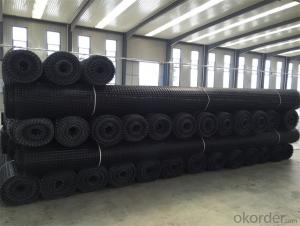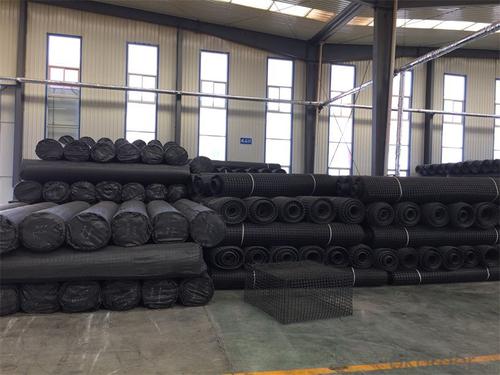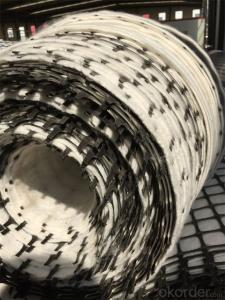Geogrid Stragrip Sg-150 - Polyester Biaxial Plastic Geogrid with High Tensile Strength Warp Knitted Cmax
- Loading Port:
- Tianjin
- Payment Terms:
- TT OR LC
- Min Order Qty:
- 20000 m²
- Supply Capability:
- 50000000 m²/month
OKorder Service Pledge
OKorder Financial Service
You Might Also Like
Fiberglass Geogrid Introduction:
Fiberglass geogrid is a kind of planar mesh material using alkali-free fiberglass yarn as base body and then coated with high quality modified asphalt. It is warp knitted with oriental structure which gives full play of yarn strength and improves its mechanical property to make the product high tensile, tearing and creep-resistant. Moreover, the composite property of coating with asphalt makes full protection of the fiberglass matrix and greatly improves its wear and shear resistance. All the advantageous functions make the product have a good performance in pavement strengthening, track cracking and solving difficulties of strengthening the bituminous pavement.
Fiberglass Geogrid Features:
1. Light weight, high tensile strength, high modulus, low elongation and good toughness.
2. Corrosion resistance, no long-term creep, long life span.
3. Good physical and chemical stability and good thermal stability.
4. Resistant to fatigue cracking, high-temperature track and low temperature shrinkage cracking.
5. Delaying and decreasing crack reflection.
Specifications | PET20-20 | PET30-30 | PET40-40 | PET50-50 | PET80-80 | PET100-100 | PET120-120 |
Elongation(%) | 10%~15% | ||||||
Vert Tensile strength(KN/m) | 20 | 30 | 40 | 50 | 80 | 100 | 120 |
Horiz Tensile strength(KN/m) | 20 | 30 | 40 | 50 | 80 | 100 | 120 |
Grid(mm) | 12.5×12.5 20×20 24.5×24.5 | ||||||
Width(m) | 1—6 | ||||||
Fiberglass Geogrid Application:
1. Road surface asphalt overlay construction engineering; Asphalt layers
reinforcement.
2. Converting old cement concrete road into composite road; Restraining
reflection cracking caused by block shrinkage.
3. Road extension; Preventing and controlling the cracking caused by new
and old combination and uneven settlement.
4. Treatment of the conjunction between tunnel and bridge or foundation.
Packaging & Shipping:









FAQ:
1. How to order your geogrid ?
a) Tensile strength in warp & weft direction
b) Grid size
c) Roll Width and length
d) Quantity
2. What is the Payment term?
a) TT
b) LC AT SIGHT
c) cash
d) 30% contact value as deposit ,the blance 70% be paid after received the copy of bl .
3. Delivery time
a) 19-25 days after received your depsit .
4. What is MQQ ?
a) 2500 m2 as MQQ , we can also produce sample for you .
Welcome to send your inquiry to us, and if you have any question, we can also help you.
- Q: How do geogrids help in reducing construction time?
- Geogrids help in reducing construction time by providing soil stabilization and reinforcement, which allows for faster and more efficient construction processes. They improve the load-bearing capacity of soils, minimize settlement and soil erosion, and enhance the overall stability of the construction site. This eliminates the need for extensive site preparation, such as excavation and compaction, and enables faster construction of foundations, roads, and other structures.
- Q: How do geogrids prevent soil erosion?
- Geogrids prevent soil erosion by providing stability and reinforcement to the soil. They are typically made of high-strength materials, such as polyester or polypropylene, and are installed within the soil to distribute and transfer loads. This helps to increase the soil's resistance to erosion caused by factors like water flow or slope instability. The geogrids act as a barrier that holds the soil particles together, preventing them from being washed away or displaced.
- Q: Can geogrids be used in mining tailings containment?
- Yes, geogrids can be used in mining tailings containment. Geogrids are commonly utilized in mining operations to reinforce and stabilize the tailings containment structures. They provide strength and stability to the containment walls, preventing soil erosion and potential leaks. Additionally, geogrids help to distribute loads and reduce settlement, ensuring the stability and longevity of the tailings containment system.
- Q: Can geogrids be used in pond liners?
- Yes, geogrids can be used in pond liners. Geogrids are commonly used in pond construction and lining applications as they provide stability and reinforcement to the liner. They help prevent soil erosion and improve the overall strength and longevity of the pond liner.
- Q: What is the typical thickness of a geogrid?
- The typical thickness of a geogrid can vary depending on the specific application and manufacturer. However, most geogrids range in thickness from 0.5 to 3 millimeters.
- Q: Can geogrids be used in retaining walls for waterfront applications?
- Yes, geogrids can be used in retaining walls for waterfront applications. Geogrids are commonly used in such applications to reinforce and stabilize the soil behind the retaining wall, providing additional strength and preventing potential erosion or failure.
- Q: How do geogrids prevent lateral spreading of soil?
- Geogrids prevent lateral spreading of soil by providing reinforcement and increased stability to the soil structure. When placed within the soil, geogrids distribute the tensile forces and restrict the movement of soil particles, reducing the potential for lateral movement. The interlocking of the geogrids with the soil creates a stronger composite material, preventing the soil from spreading laterally and maintaining its integrity.
- Q: What are the benefits of using geogrids in roadways?
- The benefits of using geogrids in roadways are numerous. Firstly, geogrids provide reinforcement to the road surface, increasing its strength and stability. This helps in preventing the formation of cracks and potholes, leading to longer-lasting and more durable roads. Secondly, geogrids help in distributing the load from vehicular traffic more evenly, reducing the stress on the road and preventing premature deterioration. Additionally, geogrids improve the overall performance of the road by enhancing its resistance to rutting, erosion, and other forms of pavement distress. Moreover, geogrids can reduce construction costs by reducing the amount of aggregate required for road construction. Overall, the use of geogrids in roadways improves their longevity, reduces maintenance needs, and enhances the safety and comfort of road users.
- Q: How do geogrids improve the load-bearing capacity of soils?
- Geogrids improve the load-bearing capacity of soils by distributing and reinforcing the applied loads, effectively increasing the soil's strength and stability. They work by interlocking with the soil particles and creating a stable composite material, preventing soil movement and reducing the risk of soil settlement or failure.
- Q: What is the tensile strength of geogrids?
- The tensile strength of geogrids can vary depending on the specific type and design, but generally, it ranges from 20 to 200 kilonewtons per meter.
Send your message to us
Geogrid Stragrip Sg-150 - Polyester Biaxial Plastic Geogrid with High Tensile Strength Warp Knitted Cmax
- Loading Port:
- Tianjin
- Payment Terms:
- TT OR LC
- Min Order Qty:
- 20000 m²
- Supply Capability:
- 50000000 m²/month
OKorder Service Pledge
OKorder Financial Service
Similar products
Hot products
Hot Searches
Related keywords































